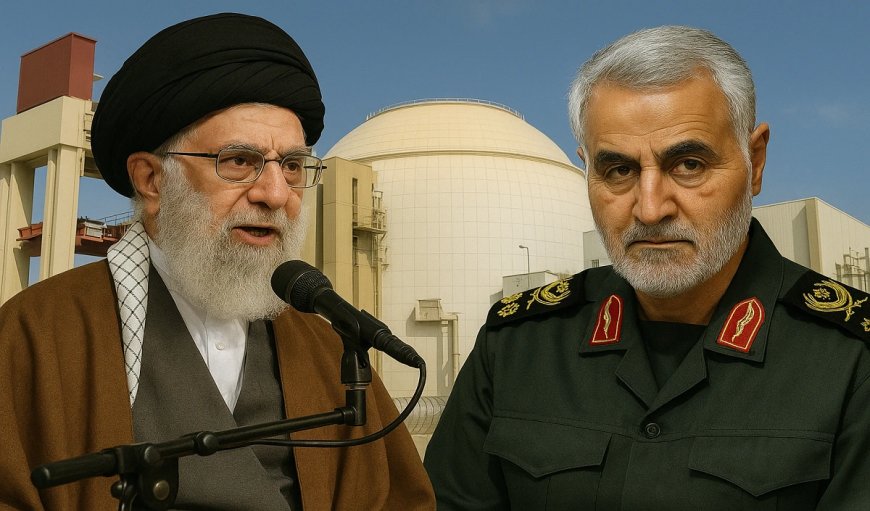5 साल में 9 सैन्य कमांडर और 7 परमाणु वैज्ञानिक गवाएं, जनरल सुलेमानी की मौत से अब तक नहीं उबर पाया ईरान
संयुक्त राष्ट्र की परमाणु देखरेख संस्था (IAEA) ने पिछले दिनों कहा था कि ईरान अपने परमाणु समझौते के दायित्वों का उल्लंघन कर रहा है। इसके बाद इजरायल और अमेरिका इस बात को लेकर चितित हो गए कि अगर ईरान को परमाणु हथियार मिला तो वह क्षेत्रीय शक्ति बन सकता है। इजरायल ने 13 जून को ईरान पर किए गए हमलों को अपने अस्तित्व पर बढ़ते परमाणु खतरे से निपटने की कार्रवाई बताया।इसे भी पढ़ें: इजरायली हमले में ईरान के 2 और टॉप जनरलों की मौत, फोर्डो न्यूक्लियर साइट को भी नुकसानमिलिट्री कमांडरों पर अटैक क्यों किया ?विश्लेषकों का कहना है कि इन हमलों के पीछे डिकैपिटेशन स्ट्राइक की रणनीति थी, यानी शीर्ष नेतृत्व को निशाना वनाकर ईरान की कमान सिस्टम को तहस-नहस करना। एक्सपर्ट मान रहे हैं कि इस्राइल का यह हमला सिर्फ परमाणु कार्यक्रम को खत्म करना नहीं, वल्कि ईरान को कड़ा जवाव देने की क्षमता से भी रोकना था।जनरल सुलेमानी की मौत से नहीं उबर पाया2020 में ईरान के ईरान के सबसे प्रभावशाली सैन्य कमांडर कासिम सुलेमानी की मौत के बाद ईरानी सेना और परमाणु कार्यक्रम संभल नहीं पाया। 5 साल में 9 सैन्य कमांडर और 7 परमाणु वैज्ञानिक मारे जा चुके हैं। शुक्रवार को ये 6 कमांडर मारे गए।इसे भी पढ़ें: ईरान ने भेद डाला इजरायल का सबसे बड़ा कवच, नेतन्याहू के 'पेंटागन' को कर दिया धुआं-धुआं1. मेजर जनरल मोहम्मद वामेरी सशस्त्र बलों के चीफ ऑफ स्टाफ, सैन्य रणनीतिकार और खुफिया विशेषतः2. जनाल हुसैन सलामी रिवोल्यूशनरी गार्ड के कमांडर-इन-चीफ।3. जनरल खोलामाली लीदः सेनाओं के उप कमांडर-इन-चीफ ईरान की ड्रोन क्षमताओं के मास्टरमाइंड।4. अली सामाधानीः सर्वोच्च राष्ट्रीय सुरक्षा परिषद के पूर्व सचिव गंभीर घायल, इलाज के दौरान मारे गए।5. फेरेदून अब्बासी-दावानी वैज्ञानिक, परमाणु हथियार रिसर्च में प्रमुख व्यक्ति थे, वे रास्ते में कार हमले में मारे गए।6. मोहम्मद मेहदी तेहरांगीः भौतिक विज्ञानी, यूरेनियम संवर्धन सलाहकार) तेहरान में फ्लैट पर हमले में मारे गए।

5 Years, 9 Military Commanders, and 7 Nuclear Scientists Lost: Iran Still Reeling from General Soleimani's Death
Breaking News, Daily Updates & Exclusive Stories - theoddnaari
By: Priya Sharma and Anjali Gupta, Team theoddnaari
Introduction
The aftermath of General Qasem Soleimani's assassination in January 2020 continues to resonate through Iran's military and scientific communities. Over the past five years, Iran has witnessed a tragic turnover, losing nine military commanders and seven key nuclear scientists. This article unpacks the implications of these losses amidst rising tensions between Iran, Israel, and the United States.
Recent Developments in Iran's Defense Landscape
According to the International Atomic Energy Agency (IAEA), Iran has been violating its nuclear agreement obligations in recent weeks. The concern is palpable among Israel and the United States as they ponder the potential repercussions of a nuclear-capable Iran. The Israeli government, on June 13, framed attacks against Iran as a necessary response to the escalating nuclear threat. This renewed focus on military action has placed Iran's already beleaguered defense establishment in a precarious position.
Reasons Behind the Military Commanders' Attacks
Analysts suggest the strategy behind these recent military attacks aligns with a "decapitation strike" approach, targeting Iran’s top leadership to destabilize its command structure. Experts indicate that this is not merely about dismantling Iran’s nuclear program but also about thwarting its capacity to respond forcefully in the region.
The Impact of General Soleimani's Death
The death of General Soleimani, one of Iran’s most formidable military leaders, has left a void that the Iranian military has struggled to fill. Following his assassination, the Iranian army and its nuclear program have faltered significantly. In just five years, Iran has mourned the loss of nine military commanders and seven nuclear scientists, exacerbating their operational challenges.
List of Commanders and Scientists Lost
Recent reports reveal the following key figures have been killed in attacks:
- Mohammad Vameeri: Chief of Staff of the Armed Forces, military strategist, and intelligence expert.
- Hosseyn Salami: Commander-in-Chief of the Revolutionary Guard.
- Kholamali Lid: Deputy Commander-in-Chief of the Armed Forces, renowned for his expertise in drone capabilities.
- Ali Samadhani: Former Secretary of the Supreme National Security Council, tragically succumbed to injuries during treatment.
- Fereydoun Abbasi-Davani: Prominent nuclear scientist killed in a targeted car attack.
- Mohammad Mehdi Tehrangi: Physicist and uranium enrichment expert fatally injured in an incident at his apartment.
The Current Situation
As Iran confronts these staggering losses, questions linger about its ability to maintain its military cohesion and nuclear ambitions. The fate of the nation's nuclear program hangs in the balance as external pressures mount and internal resources dwindle. With each loss, Iran’s capability to assert itself in a region marked by hostility shrinks further.
Conclusion
While Iran strives to recover from the cumulative impact of these high-profile assassinations, the reality of ongoing conflicts and external pressures affects its strategic landscape. The nation must navigate this challenging terrain to reclaim its status as a regional power. Understanding the complexities surrounding Iran's military and nuclear challenges remains crucial as developments unfold.







